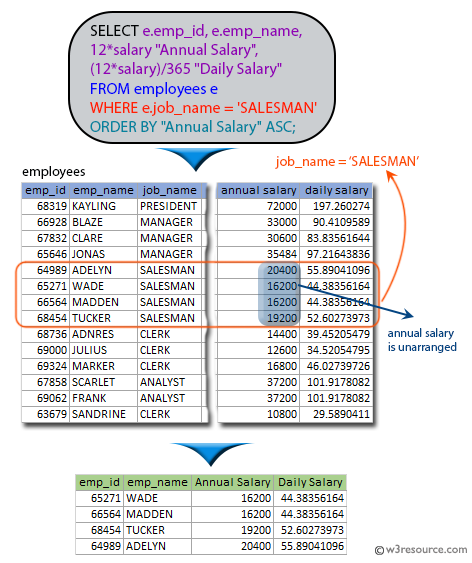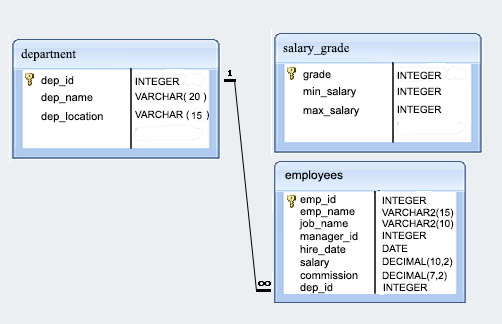SQL Exercise: Employees work as SALESMEN, sorted by their salary
[An editor is available at the bottom of the page to write and execute the scripts.]
79. From the following table, write a SQL query to list the employees who works as a SALESMAN. Sort the result set in ascending order of annual salary. Return employee id, name, annual salary, daily salary of all the employees.
Pictorial Presentation:
Sample table: employees
Sample Solution:
SELECT e.emp_id,
e.emp_name,
12*salary "Annual Salary",
(12*salary)/365 "Daily Salary"
FROM employees e
WHERE e.job_name = 'SALESMAN'
ORDER BY "Annual Salary" ASC;
Sample Output:
emp_id | emp_name | Annual Salary | Daily Salary --------+----------+---------------+--------------------- 65271 | WADE | 16200.00 | 44.3835616438356164 66564 | MADDEN | 16200.00 | 44.3835616438356164 68454 | TUCKER | 19200.00 | 52.6027397260273973 64989 | ADELYN | 20400.00 | 55.8904109589041096 (4 rows)
Explanation:
The said query in SQL that selects the employee ID, employee name, annual salary, and daily salary of all employees from 'employees' table whose job name is 'SALESMAN', and orders the results in ascending order by annual salary.
The calculation 12*salary is used to calculate the annual salary, and the "Annual Salary" alias is assigned to the result.
The WHERE clause filters the results to include only those employees whose job name is 'SALESMAN'.
The ORDER BY clause ordered the result set by annual salary in ascending order.
Go to:
PREV : Sort employees in ascending order by annual salary.
NEXT : List employees in ascending order on their experiences.
Practice Online
Sample Database: employees
Have another way to solve this solution? Contribute your code (and comments) through Disqus.
What is the difficulty level of this exercise?
Test your Programming skills with w3resource's quiz.


